Nature’s Alphabet
Plants, animals, and other natural objects may bear patterns that resemble letters, numbers, and other figures.
By Emily Sohn
Kjell Sandved was sitting on a tree branch in Panama when he found himself staring into the face of a viper. The poisonous snake had coiled its body a few times around a nearby branch. Its neck rested on the coils.
“Its head,” Sandved says, “was sticking out and looking at me.”
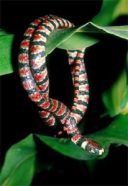 |
|
A viper has coiled itself around a branch. |
| © Kjell Sandved |
Instead of reacting with terror and panic, like most people would, Sandved noticed something remarkable. Resting in this position, the snake looked like the letter “Q.”
It wasn’t the first letter of the alphabet that Sandved had picked out while observing nature. In 1975, the talented photographer had published a poster displaying every letter in the alphabet, each one found somewhere on the wings of butterflies and moths. Later, he finished a colorful collection of letters, numbers, and symbols found throughout the natural world. Completing both alphabets consumed him for 24 years.
Now 83 years old, Sandved has continued his quest. Recent photographs include patterns that resemble faces, eyes, ampersands, the Greek letter pi, and the shapes of cats and mice.
Unusual quest
Sandved’s unusual quest began when he first traveled to the United States from his native Norway in 1960. He was 38 years old, and he was working on an encyclopedia about the natural world. He had already written encyclopedias about classical music and European art.
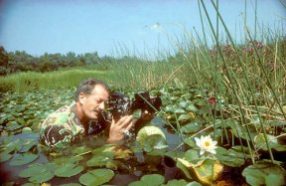 |
|
Up nearly to his neck in water, Kjell Sandved films butterfly behavior in Maryland wetlands. |
| © Butterfly Alphabet, Inc. |
When he arrived in Washington, D.C., for what he thought would be a 6-month visit, the director of the city’s Smithsonian Institution agreed to let him look through the museum’s collections.
“Then, one day, it happened,” Sandved says. “My meeting with destiny. It was a Cuban cigar box, full of butterflies and moths. There, on the wing, I saw a beautiful letter ‘F.’ I’ll never forget it. I thought, ‘My God, how can nature put something so beautiful on a butterfly’s wing?'”
Inside boxes, the butterflies had lost much of their color. So, Sandved taught himself how to take photographs. Then, he began traveling around the world, looking for more letters.
His adventures have taken him to more than 30 countries, including Brazil, Papua New Guinea, and the Philippines. He still lives in the United States.
Shapes in nature
The easiest shapes and symbols to find in nature, Sandved says, are the symmetrical ones. O’s, X’s, and I’s, for example, are more common than R’s, F’s, and G’s. “Design elements in nature,” he says, “tend to go toward symmetry.”
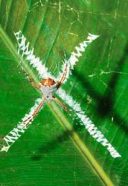 |
|
A spider waits for prey atop a sticky, white cross made of spider silk. |
| © Kjell Sandved |
Eye-like shapes are also easy to find, Sandved says. Many creatures, including butterflies, fish, and peacocks, have eye-shaped markings on their bodies as a strategy for defense. Often, the markings fool a predator into thinking that its prey is moving in one direction, when it’s actually moving in another.
Intricate patterns can also help animals attract mates, just as people might dress up or wear makeup to impress each other.
It’s probably just a coincidence that the designs we see in nature look like the letters we use. After all, our brains are trained to recognize particular patterns.
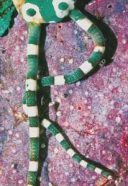 |
|
The arms of a sea creature known as a brittlestar form an “R.” |
| © Kjell Sandved |
We’re especially quick to pick out shapes that we see all the time, such as letters and numbers. Butterflies themselves don’t see K’s and Q’s. They simply see other butterflies that they want either to approach or stay away from.
Adventures in nature
For Sandved, the search for letters in nature has inspired a huge appreciation for the environment and everything in it. He marvels at the creatures, plants, and objects he discovers in the course of his adventures.
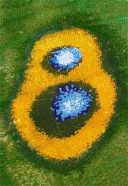 |
|
A moth’s wings bear a pattern resembling the figure “8.” |
| Credit: © Kjell Sandved |
“All finite things reveal infinitude,” reads a poem by Theodore Roethke. The poem is printed on many of Sandved’s posters.
“This is one of the deepest statements I can think of that has ever been uttered in science and life,” Sandved says. “The more I learn, the more I see that I’m totally ignorant.”
Our brains are like boxes, he says, and it can be hard to think outside of what we are comfortable with.
After many years spent observing and photographing spiders mating and then eating each other, butterflies flitting around, and other intricacies of nature, Sandved has given up on trying to understand it all. Instead, he lives his life with a sense of wonder and amazement.
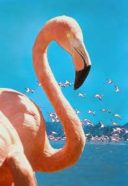 |
|
A flamingo’s neck forms a graceful “S.” |
| Credit: © Kjell Sandved |
Sandved has also been lucky enough to dedicate his life to something he loves.
“All of these things have been so much fun,” he says. And his work has paid off. His images are fascinating to look at, and they’ve become a popular tool for teaching numbers and letters to kids.
You might want to start your own quest. What letters, numbers, and other symbols can you find in the natural world around you?
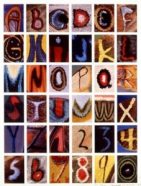 |
|
Kjell Sandved’s famous butterfly alphabet. |
|
© Butterfly Alphabet, Inc. |
Going Deeper:







